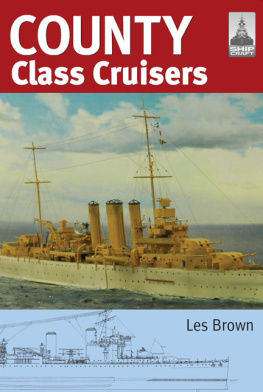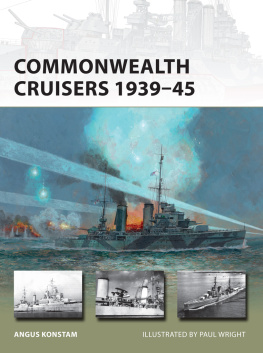Waters - British Town Class Cruisers
Here you can read online Waters - British Town Class Cruisers full text of the book (entire story) in english for free. Download pdf and epub, get meaning, cover and reviews about this ebook. year: 2019, publisher: Seaforth Publishing, genre: Romance novel. Description of the work, (preface) as well as reviews are available. Best literature library LitArk.com created for fans of good reading and offers a wide selection of genres:
Romance novel
Science fiction
Adventure
Detective
Science
History
Home and family
Prose
Art
Politics
Computer
Non-fiction
Religion
Business
Children
Humor
Choose a favorite category and find really read worthwhile books. Enjoy immersion in the world of imagination, feel the emotions of the characters or learn something new for yourself, make an fascinating discovery.
- Book:British Town Class Cruisers
- Author:
- Publisher:Seaforth Publishing
- Genre:
- Year:2019
- Rating:4 / 5
- Favourites:Add to favourites
- Your mark:
- 80
- 1
- 2
- 3
- 4
- 5
British Town Class Cruisers: summary, description and annotation
We offer to read an annotation, description, summary or preface (depends on what the author of the book "British Town Class Cruisers" wrote himself). If you haven't found the necessary information about the book — write in the comments, we will try to find it.
British Town Class Cruisers — read online for free the complete book (whole text) full work
Below is the text of the book, divided by pages. System saving the place of the last page read, allows you to conveniently read the book "British Town Class Cruisers" online for free, without having to search again every time where you left off. Put a bookmark, and you can go to the page where you finished reading at any time.
Font size:
Interval:
Bookmark:

BRITISH TOWN CLASS CRUISERS
DESIGN, DEVELOPMENT & PERFORMANCE SOUTHAMPTON & BELFAST CLASSES
CONRAD WATERS


Previous pages: Edinburgh the last Town to be laid down but not the last to be completed pictured during the course of acceptance trials on 6 July 1939. She was accepted from builders Swan Hunter & Wigham Richardson at 21.40 that evening. The two 10,000-ton 6in cruisers also referred to as the Improved Southampton class, Belfast and Edinburgh and the Belfast class in official reports ordered under the Royal Navys 1936 construction programme incorporated significant differences from the earlier Towns. (Authors collection)
Text copyright Conrad Waters 2019
Drawings and artwork by and A D Baker III, John Dominy, John Jordan and George Richardson
This edition first published in Great Britain in 2019 by
Seaforth Publishing,
An imprint of Pen & Sword Books Ltd,
47 Church Street,
Barnsley
South Yorkshire S70 2AS
www.seaforthpublishing.com
Email:
British Library Cataloguing in Publication Data
A catalogue record for this book is available from the British Library
ISBN 978 1 5267 1885 3 (Hardback)
ISBN 978 1 5267 1886 0 (Kindle)
ISBN 978 1 5267 1887 7 (ePub)
All rights reserved. No part of this publication may be reproduced or transmitted in any form or by any means, electronic or mechanical, including photocopying, recording, or any information storage and retrieval system, without prior permission in writing of both the copyright owner and the above publisher.
The right of Conrad Waters to be identified as the author of this work has been asserted in accordance with the Copyright, Designs and Patents Act 1988
Pen & Sword Books Limited incorporates the imprints of Atlas, Archaeology, Aviation, Discovery, Family History, Fiction, History, Maritime, Military, Military Classics, Politics, Select,Transport,True Crime, Air World, Frontline Publishing, Leo Cooper, Remember When, Seaforth Publishing,The Praetorian Press,Wharncliffe Local History,Wharncliffe Transport, Wharncliffe True Crime and White Owl.
A T 18.15 ON THURSDAY 3 AUGUST 1939, the tenth and final Town class cruiser, HMS Belfast , was accepted from her builders, Harland and Wolff Limited, on behalf of the Admiralty by her new commanding officer, Captain G A Scott, whilst the ship lay at anchor in Belfast Lough. A short commissioning service was conducted by the cruisers chaplain and after a slight delay caused by difficulties lowering the Red Ensign her White Ensign was hoisted for the first time. At 19.11 Belfast weighed anchor and four minutes later she was underway bound for her home port of Portsmouth. Just one month later, the British deadline for a halt to Hitlers invasion of Poland expired and the Royal Navy commenced hostilities with Germany for the second time in a generation.
Entering service between 1937 and 1939, the ten Town class cruisers were the most modern vessels of their type in the Royal Navy when the Second World War began. Constructed in the era of naval arms limitation treaties, they were conceived in the early 1930s as a response to the emergence of heavily-armed American and Japanese ships and represented a step-change from initial British 6in gun-armed light cruiser designs. In spite of this, they continued to reflect the balance of compromises with respect to firepower, protection and speed inherent in displacement-limited treaty cruisers. Primarily intended for the defence of trade, they were destined to see arduous service in a wide range of roles.
The Towns were ordered in four batches under the Royal Navys 19331936 construction programmes. They were initially to be named after fabulous monsters and known as the Minotaur class. However, a change of heart after the two 1933 programme ships had been laid down saw the naming policy revised to celebrate important cities. The leading pair adopted the names Newcastle and Southampton in consequence. Southampton was designated as the class name and this was also applied to the six similar ships ordered under the 1934 and 1935 programmes. However, both batches and particularly the 1935 ships incorporated differences which resulted in them being respectively referred to as the Birmingham and Gloucester sub-classes in some documents. The final pair ordered in 1936 were built to a larger design and referenced as the 10,000-ton 6in cruiser, the Improved Southampton class, Belfast and Edinburgh and the Belfast class in official reports.Although commonly known as the Edinburgh class in many recent publications, the author has not been able to trace official use of this designation in contemporary documentation. Collectively even in official documents the class quickly became known as the Towns.
As modern ships, the Towns were at the heart of Royal Navy cruiser operations throughout the Second World War. They served in all theatres, playing a decisive role in victories such as the Battle of the Barents Sea and the destruction of Germanys Scharnhorst at the North Cape. The cost was heavy; four of the ships were lost and the other six all survived heavy damage, in some cases on more than one occasion. All of the class were progressively modernised to incorporate the latest technological developments, in many ways equipping them to fight a different kind of naval warfare than that envisaged when they were first conceived. This process continued after the war, the bulk of the class serving into the late 1950s. Belfast became the sole treaty cruiser to be preserved when she was finally paid off for disposal in 1971.
The stories of many individual Towns have been printed over the years and an operational history of the class written by Neil McCart was published in 2012. However, the only monograph to undertake a comprehensive review of the classs design and wartime performance Alan Ravens and John Roberts compact Town Class Cruisers dates from as long ago as 1975 and does not encompass post-war design changes. With much additional information now in the public domain, it is possible to provide an updated, more detailed account of one of the most important Royal Navy designs of the period.
This book is essentially a technical history. It aims to explain why the Town class was built; to recount the design and construction process; and to describe the main features of the resulting ships. It also assesses the wartime changes that were adopted in the light of technological advances and practical experience, as well as the later modernisation programmes that kept the remaining ships fit for service during the early Cold War era. Whilst not a detailed operational history, it attempts to evaluate the extent to which the class met its designers expectations on active service, appraising the consequences of various incidences of action damage. Whilst the Towns were not without their detractors, the author hopes to demonstrate the classs design team produced a practical and resilient group of ships that proved equal to the many demands placed on them.
ACKNOWLEDGEMENTS
A book of this nature is only possible with the help of many. First, I am indebted to Seaforths Rob Gardiner for allowing me to undertake the project and for providing considerable ongoing assistance. I must also thank Dave Baker, John Jordan and George Richardson for producing many of the books illustrations, as well as the Aston & Weston Branch of the Royal British Legion for agreeing to the use of the late John R Dominys drawings and considerable research. Various aspects of the book have benefitted from the advice and help of Roger Branfill-Cook, Richard Dennis, Jamie Duff, Norman Friedman, Ian Gazeley, Peter Marland, Alan Raven, John Roberts and John Weal, although I must single out John Jordans patient and consistent support. Rick E Davis, Stephen Dent, David Hobbs, Ian Johnston, Miles F McLaughlin, Richard Osborne and Roger Torgeson have all helped with the sourcing of photographs from official and private sources.
Font size:
Interval:
Bookmark:
Similar books «British Town Class Cruisers»
Look at similar books to British Town Class Cruisers. We have selected literature similar in name and meaning in the hope of providing readers with more options to find new, interesting, not yet read works.
Discussion, reviews of the book British Town Class Cruisers and just readers' own opinions. Leave your comments, write what you think about the work, its meaning or the main characters. Specify what exactly you liked and what you didn't like, and why you think so.


















